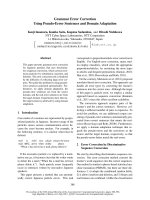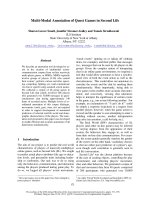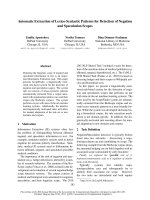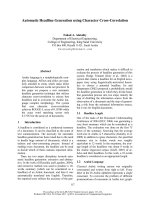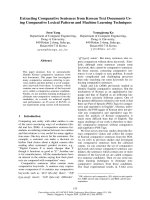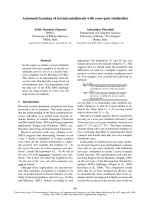Báo cáo khoa học: "Automatic Image Annotation Using Auxiliary Text Information" potx
Bạn đang xem bản rút gọn của tài liệu. Xem và tải ngay bản đầy đủ của tài liệu tại đây (933.13 KB, 9 trang )
Proceedings of ACL-08: HLT, pages 272–280,
Columbus, Ohio, USA, June 2008.
c
2008 Association for Computational Linguistics
Automatic Image Annotation Using Auxiliary Text Information
Yansong Feng and Mirella Lapata
School of Informatics, University of Edinburgh
2 Buccleuch Place, Edinburgh EH8 9LW, UK
,
Abstract
The availability of databases of images labeled
with keywords is necessary for developing and
evaluating image annotation models. Dataset
collection is however a costly and time con-
suming task. In this paper we exploit the vast
resource of images available on the web. We
create a database of pictures that are natu-
rally embedded into news articles and propose
to use their captions as a proxy for annota-
tion keywords. Experimental results show that
an image annotation model can be developed
on this dataset alone without the overhead of
manual annotation. We also demonstrate that
the news article associated with the picture
can be used to boost image annotation perfor-
mance.
1 Introduction
As the number of image collections is rapidly grow-
ing, so does the need to browse and search them.
Recent years have witnessed significant progress in
developing methods for image retrieval
1
, many of
which are query-based. Given a database of images,
each annotated with keywords, the query is used to
retrieve relevant pictures under the assumption that
the annotations can essentially capture their seman-
tics.
One stumbling block to the widespread use of
query-based image retrieval systems is obtaining the
keywords for the images. Since manual annotation
is expensive, time-consuming and practically infea-
sible for large databases, there has been great in-
1
The approaches are too numerous to list; we refer the inter-
ested reader to Datta et al. (2005) for an overview.
terest in automating the image annotation process
(see references). More formally, given an image I
with visual features V
i
= {v
1
,v
2
, ,v
N
} and a set
of keywords W = {w
1
,w
2
, ,w
M
}, the task con-
sists in finding automatically the keyword subset
W
I
⊂ W, which can appropriately describe the im-
age I. Indeed, several approaches have been pro-
posed to solve this problem under a variety of learn-
ing paradigms. These range from supervised clas-
sification (Vailaya et al., 2001; Smeulders et al.,
2000) to instantiations of the noisy-channel model
(Duygulu et al., 2002), to clustering (Barnard et al.,
2002), and methods inspired by information retrieval
(Lavrenko et al., 2003; Feng et al., 2004).
Obviously in order to develop accurate image an-
notation models, some manually labeled data is re-
quired. Previous approaches have been developed
and tested almost exclusively on the Corel database.
The latter contains 600 CD-ROMs, each contain-
ing about 100 images representing the same topic
or concept, e.g., people, landscape, male. Each topic
is associated with keywords and these are assumed
to also describe the images under this topic. As an
example consider the pictures in Figure 1 which are
classified under the topic male and have the descrip-
tion keywords man, male, people, cloth, and face.
Current image annotation methods work well
when large amounts of labeled images are available
but can run into severe difficulties when the number
of images and keywords for a given topic is rela-
tively small. Unfortunately, databases like Corel are
few and far between and somewhat idealized. Corel
contains clusters of many closely related images
which in turn share keyword descriptions, thus al-
lowing models to learn image-keyword associations
272
Figure 1: Images from the Corel database, exemplifying
the concept male with keyword descriptions man, male,
people, cloth, and face.
reliably (Tang and Lewis, 2007). It is unlikely that
models trained on this database will perform well
out-of-domain on other image collections which are
more noisy and do not share these characteristics.
Furthermore, in order to develop robust image anno-
tation models, it is crucial to have large and diverse
datasets both for training and evaluation.
In this work, we aim to relieve the data acquisition
bottleneck associated with automatic image annota-
tion by taking advantage of resources where images
and their annotations co-occur naturally. News arti-
cles associated with images and their captions spring
readily to mind (e.g., BBC News, Yahoo News). So,
rather than laboriously annotating images with their
keywords, we simply treat captions as labels. These
annotations are admittedly noisy and far from ideal.
Captions can be denotative (describing the objects
the image depicts) but also connotative (describ-
ing sociological, political, or economic attitudes re-
flected in the image). Importantly, our images are not
standalone, they come with news articles whose con-
tent is shared with the image. So, by processing the
accompanying document, we can effectively learn
about the image and reduce the effect of noise due
to the approximate nature of the caption labels. To
give a simple example, if two words appear both in
the caption and the document, it is more likely that
the annotation is genuine.
In what follows, we present a new database con-
sisting of articles, images, and their captions which
we collected from an on-line news source. We
then propose an image annotation model which can
learn from our noisy annotations and the auxil-
iary documents. Specifically, we extend and mod-
ify Lavrenko’s (2003) continuous relevance model
to suit our task. Our experimental results show that
this model can successfully scale to our database,
without making use of explicit human annotations
in any way. We also show that the auxiliary docu-
ment contains important information for generating
more accurate image descriptions.
2 Related Work
Automatic image annotation is a popular task in
computer vision. The earliest approaches are closely
related to image classification (Vailaya et al., 2001;
Smeulders et al., 2000), where pictures are assigned
a set of simple descriptions such as indoor, out-
door, landscape, people, animal. A binary classifier
is trained for each concept, sometimes in a “one vs
all” setting. The focus here is mostly on image pro-
cessing and good feature selection (e.g., colour, tex-
ture, contours) rather than the annotation task itself.
Recently, much progress has been made on the
image annotation task thanks to three factors. The
availability of the Corel database, the use of unsu-
pervised methods and new insights from the related
fields of natural language processing and informa-
tion retrieval. The co-occurrence model (Mori et al.,
1999) collects co-occurrence counts between words
and image features and uses them to predict anno-
tations for new images. Duygulu et al. (2002) im-
prove on this model by treating image regions and
keywords as a bi-text and using the EM algorithm to
construct an image region-word dictionary.
Another way of capturing co-occurrence informa-
tion is to introduce latent variables linking image
features with words. Standard latent semantic anal-
ysis (LSA) and its probabilistic variant (PLSA) have
been applied to this task (Hofmann, 1998). Barnard
et al. (2002) propose a hierarchical latent model
in order to account for the fact that some words
are more general than others. More sophisticated
graphical models (Blei and Jordan, 2003) have also
been employed including Gaussian Mixture Models
(GMM) and Latent Dirichlet Allocation (LDA).
Finally, relevance models originally developed for
information retrieval, have been successfully applied
to image annotation (Lavrenko et al., 2003; Feng et
al., 2004). A key idea behind these models is to find
the images most similar to the test image and then
use their shared keywords for annotation.
Our approach differs from previous work in two
273
important respects. Firstly, our ultimate goal is to de-
velop an image annotation model that can cope with
real-world images and noisy data sets. To this end
we are faced with the challenge of building an ap-
propriate database for testing and training purposes.
Our solution is to leverage the vast resource of im-
ages available on the web but also the fact that many
of these images are implicitly annotated. For exam-
ple, news articles often contain images whose cap-
tions can be thought of as annotations. Secondly, we
allow our image annotation model access to knowl-
edge sources other than the image and its keywords.
This is relatively straightforward in our case; an im-
age and its accompanying document have shared
content, and we can use the latter to glean informa-
tion about the former. But we hope to illustrate the
more general point that auxiliary linguistic informa-
tion can indeed bring performance improvements on
the image annotation task.
3 BBC News Database
Our database consists of news images which are
abundant. Many on-line news providers supply pic-
tures with news articles, some even classify news
into broad topic categories (e.g., business, world,
sports, entertainment). Importantly, news images of-
ten display several objects and complex scenes and
are usually associated with captions describing their
contents. The captions are image specific and use a
rich vocabulary. This is in marked contrast to the
Corel database whose images contain one or two
salient objects and a limited vocabulary (typically
around 300 words).
We downloaded 3,361 news articles from the
BBC News website.
2
Each article was accompa-
nied with an image and its caption. We thus created
a database of image-caption-document tuples. The
documents cover a wide range of topics including
national and international politics, advanced tech-
nology, sports, education, etc. An example of an en-
try in our database is illustrated in Figure 2. Here,
the image caption is Marcin and Florent face intense
competition from outside Europe and the accompa-
nying article discusses EU subsidies to farmers. The
images are usually 203 pixels wide and 152 pix-
els high. The average caption length is 5.35 tokens,
and the average document length 133.85 tokens. Our
2
/>Figure 2: A sample from our BBC News database. Each
entry contains an image, a caption for the image, and the
accompanying document with its title.
captions have a vocabulary of 2,167 words and our
documents 6,253. The vocabulary shared between
captions and documents is 2,056 words.
4 Extending the Continuous Relevance
Annotation Model
Our work is an extension of the continuous rele-
vance annotation model put forward in Lavrenko
et al. (2003). Unlike other unsupervised approaches
where a set of latent variables is introduced, each
defining a joint distribution on the space of key-
words and image features, the relevance model cap-
tures the joint probability of images and annotated
words directly, without requiring an intermediate
clustering stage. This model is a good point of de-
parture for our task for several reasons, both theo-
retical and empirical. Firstly, expectations are com-
puted over every single point in the training set and
274
therefore parameters can be estimated without EM.
Indeed, Lavrenko et al. achieve competitive perfor-
mance with latent variable models. Secondly, the
generation of feature vectors is modeled directly,
so there is no need for quantization. Thirdly, as we
show below the model can be easily extended to in-
corporate information outside the image and its key-
words.
In the following we first lay out the assumptions
underlying our model. We next describe the contin-
uous relevance model in more detail and present our
extensions and modifications.
Assumptions Since we are using a non-
standard database, namely images embedded in doc-
uments, it is important to clarify what we mean by
image annotation, and how the precise nature of our
data impacts the task. We thus make the following
assumptions:
1. The caption describes the content of the image
directly or indirectly. Unlike traditional image
annotation where keywords describe salient ob-
jects, captions supply more detailed informa-
tion, not only about objects, and their attributes,
but also events. In Figure 2 the caption men-
tions Marcin and Florent the two individuals
shown in the picture but also the fact that they
face competition from outside Europe.
2. Since our images are implicitly rather than ex-
plicitly labeled, we do not assume that we can
annotate all objects present in the image. In-
stead, we hope to be able to model event-related
information such as “what happened”, “who
did it”, “when” and “where”. Our annotation
task is therefore more semantic in nature than
traditionally assumed.
3. The accompanying document describes the
content of the image. This is trivially true for
news documents where the images convention-
ally depict events, objects or people mentioned
in the article.
To validate these assumptions, we performed the
following experiment on our BBC News dataset.
We randomly selected 240 image-caption pairs
and manually assessed whether the caption content
words (i.e., nouns, verbs, and adjectives) could de-
scribe the image. We found out that the captions
express the picture’s content 90% of the time. Fur-
thermore, approximately 88% of the nouns in sub-
ject or object position directly denote salient picture
objects. We thus conclude that the captions contain
useful information about the picture and can be used
for annotation purposes.
Model Description The continuous relevance
image annotation model (Lavrenko et al., 2003)
generatively learns the joint probability distribu-
tion P(V,W ) of words W and image regions V . The
key assumption here is that the process of generating
images is conditionally independent from the pro-
cess of generating words. Each annotated image in
the training set is treated as a latent variable. Then
for an unknown image I, we estimate:
P(V
I
,W
I
) =
∑
s∈D
P(V
I
|s)P(W
I
|s)P(s), (1)
where D is the number of images in the training
database, V
I
are visual features of the image regions
representing I, W
I
are the keywords of I, s is a la-
tent variable (i.e., an image-annotation pair), and
P(s) the prior probability of s. The latter is drawn
from a uniform distribution:
P(s) =
1
N
D
(2)
where N
D
is number of the latent variables in the
training database D.
When estimating P(V
I
|s), the probability of im-
age regions and words, Lavrenko et al. (2003) rea-
sonably assume a generative Gaussian kernel distri-
bution for the image regions:
(3)
P(V
I
|s) =
N
V
I
∏
r=1
P
g
(v
r
|s)
=
N
V
I
∏
r=1
1
n
s
v
n
s
v
∑
i=1
exp{(v
r
− v
i
)
T
Σ
−1
(v
r
− v
i
)}
2
k
π
k
|
Σ
|
where N
V
I
is the number of regions in image I, v
r
the
feature vector for region r in image I, n
s
v
the number
of regions in the image of latent variable s, v
i
the fea-
ture vector for region i in s’s image, k the dimension
of the image feature vectors and Σ the feature covari-
ance matrix. According to equation (3), a Gaussian
kernel is fit to every feature vector v
i
corresponding
to region i in the image of the latent variable s. Each
kernel here is determined by the feature covariance
matrix Σ, and for simplicity, Σ is assumed to be a
diagonal matrix: Σ = βI, where I is the identity ma-
trix; and β is a scalar modulating the bandwidth of
275
the kernel whose value is optimized on the develop-
ment set.
Lavrenko et al. (2003) estimate the word prob-
abilities P(W
I
|s) using a multinomial distribution.
This is a reasonable assumption in the Corel dataset,
where the annotations have similar lengths and the
words reflect the salience of objects in the image (the
multinomial model tends to favor words that appear
multiple times in the annotation). However, in our
dataset the annotations have varying lengths, and do
not necessarily reflect object salience. We are more
interested in modeling the presence or absence of
words in the annotation and thus use the multiple-
Bernoulli distribution to generate words (Feng et al.,
2004). And rather than relying solely on annotations
in the training database, we can also take the accom-
panying document into account using a weighted
combination.
The probability of sampling a set of words W
given a latent variable s from the underlying multiple
Bernoulli distribution that has generated the training
set D is:
P(W|s) =
∏
w∈W
P(w|s)
∏
w/∈W
(1 − P(w|s)) (4)
where P(w|s) denotes the probability of the w’th
component of the multiple Bernoulli distribution.
Now, in estimating P(w|s) we can include the docu-
ment as:
P
est
(w|s) = αP
est
(w|s
a
) + (1 − α)P
est
(w|s
d
) (5)
where α is a smoothing parameter tuned on the de-
velopment set, s
a
is the annotation for the latent vari-
able s and s
d
its corresponding document.
Equation (5) smooths the influence of the annota-
tion words and allows to offset the negative effect of
the noise inherent in our dataset. Since our images
are implicitly annotated, there is no guarantee that
the annotations are all appropriate. By taking into
account P
est
(w|s
d
), it is possible to annotate an im-
age with a word that appears in the document but is
not included in the caption.
We use a Bayesian framework for estimat-
ing P
est
(w|s
a
). Specifically, we assume a beta prior
(conjugate to the Bernoulli distribution) for each
word:
P
est
(w|s
a
) =
µ b
w,s
a
+ N
w
µ + D
(6)
where µ is a smoothing parameter estimated on the
development set, b
w,s
a
is a Boolean variable denoting
whether w appears in the annotation s
a
, and N
w
is
the number of latent variables that contain w in their
annotations.
We estimate P
est
(w|s
d
) using maximum likeli-
hood estimation (Ponte and Croft, 1998):
P
est
(w|s
d
) =
num
w,s
d
num
s
d
(7)
where num
w,s
d
denotes the frequency of w in the ac-
companying document of latent variable s and num
s
d
the number of all tokens in the document. Note that
we purposely leave P
est
unsmoothed, since it is used
as a means of balancing the weight of word frequen-
cies in annotations. So, if a word does not appear in
the document, the possibility of selecting it will not
be greater than α (see Equation (5)).
Unfortunately, including the document in the es-
timation of P
est
(w|s) increases the vocabulary which
in turn increases computation time. Given a test
image-document pair, we must evaluate P(w|V
I
) for
every w in our vocabulary which is the union of
the caption and document words. We reduce the
search space, by scoring each document word with
its tf ∗ idf weight (Salton and McGill, 1983) and
adding the n-best candidates to our caption vocabu-
lary. This way the vocabulary is not fixed in advance
for all images but changes dynamically depending
on the document at hand.
Re-ranking the Annotation Hypotheses It is
easy to see that the output of our model is a ranked
word list. Typically, the k-best words are taken to
be the automatic annotations for a test image I
(Duygulu et al., 2002; Lavrenko et al., 2003; Jeon
and Manmatha, 2004) where k is a small number and
the same for all images.
So far we have taken account of the auxiliary doc-
ument rather naively, by considering its vocabulary
in the estimation of P(W|s). Crucially, documents
are written with one or more topics in mind. The im-
age (and its annotations) are likely to represent these
topics, so ideally our model should prefer words that
are strong topic indicators. A simple way to imple-
ment this idea is by re-ranking our k-best list accord-
ing to a topic model estimated from the entire docu-
ment collection.
Specifically, we use Latent Dirichlet Allocation
(LDA) as our topic model (Blei et al., 2003). LDA
276
represents documents as a mixture of topics and has
been previously used to perform document classi-
fication (Blei et al., 2003) and ad-hoc information
retrieval (Wei and Croft, 2006) with good results.
Given a collection of documents and a set of latent
variables (i.e., the number of topics), the LDA model
estimates the probability of topics per document and
the probability of words per topic. The topic mix-
ture is drawn from a conjugate Dirichlet prior that
remains the same for all documents.
For our re-ranking task, we use the LDA model
to infer the m-best topics in the accompanying doc-
ument. We then select from the output of our model
those words that are most likely according to these
topics. To give a concrete example, let us assume
that for a given image our model has produced
five annotations, w
1
, w
2
, w
3
, w
4
, and w
5
. However,
according to the LDA model neither w
2
nor w
5
are likely topic indicators. We therefore remove w
2
and w
5
and substitute them with words further down
the ranked list that are topical (e.g., w
6
and w
7
).
An advantage of using LDA is that at test time we
can perform inference without retraining the topic
model.
5 Experimental Setup
In this section we discuss our experimental design
for assessing the performance of the model pre-
sented above. We give details on our training pro-
cedure and parameter estimation, describe our fea-
tures, and present the baseline methods used for
comparison with our approach.
Data Our model was trained and tested on the
database introduced in Section 3. We used 2,881
image-caption-document tuples for training, 240 tu-
ples for development and 240 for testing. The docu-
ments and captions were part-of-speech tagged and
lemmatized with Tree Tagger (Schmid, 1994).Words
other than nouns, verbs, and adjectives were dis-
carded. Words that were attested less than five times
in the training set were also removed to avoid unre-
liable estimation. In total, our vocabulary consisted
of 8,309 words.
Model Parameters Images are typically seg-
mented into regions prior to training. We impose a
fixed-size rectangular grid on each image rather than
attempting segmentation using a general purpose al-
gorithm such as normalized cuts (Shi and Malik,
Color
average of RGB components, standard deviation
average of LUV components, standard deviation
average of LAB components, standard deviation
Texture
output of DCT transformation
output of Gabor filtering (4 directions, 3 scales)
Shape
oriented edge (4 directions)
ratio of edge to non-edge
Table 2: Set of image features used in our experiments.
2000). Using a grid avoids unnecessary errors from
image segmentation algorithms, reduces computa-
tion time, and simplifies parameter estimation (Feng
et al., 2004). Taking the small size and low resolu-
tion of the BBC News images into account, we av-
eragely divide each image into 6 × 5 rectangles and
extract features for each region. We use 46 features
based on color, texture, and shape. They are summa-
rized in Table 2.
The model presented in Section 4 has a few pa-
rameters that must be selected empirically on the
development set. These include the vocabulary size,
which is dependent on the n words with the high-
est tf ∗ idf scores in each document, and the num-
ber of topics for the LDA-based re-ranker. We ob-
tained best performance with n set to 100 (no cutoff
was applied in cases where the vocabulary was less
than 100). We trained an LDA model with 20 top-
ics on our document collection using David Blei’s
implementation.
3
We used this model to re-rank the
output of our annotation model according to the
three most likely topics in each document.
Baselines We compared our model against
three baselines. The first baseline is based on tf ∗ idf
(Salton and McGill, 1983). We rank the document’s
content words (i.e., nouns, verbs, and adjectives) ac-
cording to their tf ∗ idf weight and select the top k
to be the final annotations. Our second baseline sim-
ply annotates the image with the document’s title.
Again we only use content words (the average title
length in the training set was 4.0 words). Our third
baseline is Lavrenko et al.’s (2003) continuous rel-
evance model. It is trained solely on image-caption
3
Available from />lda-c/index.html.
277
Model Top 10 Top 15 Top 20
Precision Recall F1 Precision Recall F1 Precision Recall F1
tf ∗ idf 4.37 7.09 5.41 3.57 8.12 4.86 2.65 8.89 4.00
DocTitle 9.22 7.03 7.20 9.22 7.03 7.20 9.22 7.03 7.20
Lavrenko03 9.05 16.01 11.81 7.73 17.87 10.71 6.55 19.38 9.79
ExtModel 14.72 27.95 19.82 11.62 32.99 17.18 9.72 36.77 15.39
Table 1: Automatic image annotation results on the BBC News database.
pairs, uses a vocabulary of 2,167 words and the same
features as our extended model.
Evaluation Our evaluation follows the exper-
imental methodology proposed in Duygulu et al.
(2002). We are given an un-annotated image I and
are asked to automatically produce suitable anno-
tations for I. Given a set of image regions V
I
, we
use equation (1) to derive the conditional distribu-
tion P(w|V
I
). We consider the k-best words as the an-
notations for I. We present results using the top 10,
15, and 20 annotation words. We assess our model’s
performance using precision/recall and F1. In our
task, precision is the percentage of correctly anno-
tated words over all annotations that the system sug-
gested. Recall, is the percentage of correctly anno-
tated words over the number of genuine annotations
in the test data. F1 is the harmonic mean of precision
and recall. These measures are averaged over the set
of test words.
6 Results
Our experiments were driven by three questions:
(1) Is it possible to create an annotation model from
noisy data that has not been explicitly hand labeled
for this task? (2) What is the contribution of the
auxiliary document? As mentioned earlier, consid-
ering the document increases the model’s compu-
tational complexity, which can be justified as long
as we demonstrate a substantial increase in perfor-
mance. (3) What is the contribution of the image?
Here, we are trying to assess if the image features
matter. For instance, we could simply generate an-
notation words by processing the document alone.
Our results are summarized in Table 1. We com-
pare the annotation performance of the model pro-
posed in this paper (ExtModel) with Lavrenko et
al.’s (2003) original continuous relevance model
(Lavrenko03) and two other simpler models which
do not take the image into account (tf ∗ idf and Doc-
Title). First, note that the original relevance model
performs best when the annotation output is re-
stricted to 10 words with an F1 of 11.81% (recall
is 9.05 and precision 16.01). F1 is marginally worse
with 15 output words and decreases by 2% with 20.
This model does not take any document-based in-
formation into account, it is trained solely on image-
caption pairs. On the Corel test set the same model
obtains a precision of 19.0% and a recall of 16.0%
with a vocabulary of 260 words. Although these re-
sults are not strictly comparable with ours due to the
different nature of the training data (in addition, we
output 10 annotation words, whereas Lavrenko et al.
(2003) output 5), they give some indication of the
decrease in performance incurred when using a more
challenging dataset. Unlike Corel, our images have
greater variety, non-overlapping content and employ
a larger vocabulary (2,167 vs. 260 words).
When the document is taken into account (see
ExtModel in Table 1), F1 improves by 8.01% (re-
call is 14.72% and precision 27.95%). Increasing
the size of the output annotations to 15 or 20 yields
better recall, at the expense of precision. Eliminat-
ing the LDA reranker from the extended model de-
creases F1 by 0.62%. Incidentally, LDA can be also
used to rerank the output of Lavrenko et al.’s (2003)
model. LDA also increases the performance of this
model by 0.41%.
Finally, considering the document alone, without
the image yields inferior performance. This is true
for the tf ∗ idf model and the model based on the
document titles.
4
Interestingly, the latter yields pre-
cision similar to Lavrenko et al. (2003). This is prob-
ably due to the fact that the document’s title is in a
sense similar to a caption. It often contains words
that describe the document’s gist and expectedly
4
Reranking the output of these models with LDA slightly
decreases performance (approximately by 0.2%).
278
tf ∗ idf breastfeed, medical,
intelligent, health, child
culturalism, faith, Muslim, sepa-
rateness, ethnic
ceasefire, Lebanese, disarm, cab-
inet, Haaretz
DocTitle Breast milk does not boost IQ UK must tackle ethnic tensions Mid-East hope as ceasefire begins
Lavrenko03 woman, baby, hospital, new,
day, lead, good, England,
look, family
bomb, city, want, day, fight,
child, attack, face, help, govern-
ment
war, carry, city, security, Israeli,
attack, minister, force, govern-
ment, leader
ExtModel breastfeed, intelligent, baby,
mother, tend, child, study,
woman, sibling, advantage
aim, Kelly, faith, culturalism,
community, Ms, tension, com-
mission, multi, tackle, school
Lebanon, Israeli, Lebanese,
aeroplane, troop, Hezbollah,
Israel, force, ceasefire, grey
Caption
Breastfed babies tend to be
brighter
Segregation problems were
blamed for 2001’s Bradford riots
Thousands of Israeli troops are in
Lebanon as the ceasefire begins
Figure 3: Examples of annotations generated by our model (ExtModel), the continuous relevance model (Lavrenko03),
and the two baselines based on tf ∗ idf and the document title (DocTitle). Words in bold face indicate exact matches,
underlined words are semantically compatible. The original captions are in the last row.
some of these words will be also appropriate for the
image. In fact, in our dataset, the title words are a
subset of those found in the captions.
Examples of the annotations generated by our
model are shown in Figure 3. We also include the
annotations produced by Lavrenko et. al’s (2003)
model and the two baselines. As we can see our
model annotates the image with words that are not
always included in the caption. Some of these are
synonyms of the caption words (e.g., child and intel-
ligent in left image of Figure 3), whereas others ex-
press additional information (e.g., mother, woman).
Also note that complex scene images remain chal-
lenging (see the center image in Figure 3). Such im-
ages are better analyzed at a higher resolution and
probably require more training examples.
7 Conclusions and Future Work
In this paper, we describe a new approach for the
collection of image annotation datasets. Specifically,
we leverage the vast resource of images available
on the Internet while exploiting the fact that many
of them are labeled with captions. Our experiments
show that it is possible to learn an image annotation
model from caption-picture pairs even if these are
not explicitly annotated in any way. We also show
that the annotation model benefits substantially from
additional information, beyond the caption or image.
In our case this information is provided by the news
documents associated with the pictures. But more
generally our results indicate that further linguistic
knowledge is needed to improve performance on the
image annotation task. For instance, resources like
WordNet (Fellbaum, 1998) can be used to expand
the annotations by exploiting information about is-a
relationships.
The uses of the database discussed in this article
are many and varied. An interesting future direction
concerns the application of the proposed model in a
semi-supervised setting where the annotation output
is iteratively refined with some manual intervention.
Another possibility would be to use the document
to increase the annotation keywords by identifying
synonyms or even sentences that are similar to the
image caption. Also note that our analysis of the ac-
companying document was rather shallow, limited
to part of speech tagging. It is reasonable to assume
that results would improve with more sophisticated
preprocessing (i.e., named entity recognition, pars-
ing, word sense disambiguation). Finally, we also
believe that the model proposed here can be usefully
employed in an information retrieval setting, where
the goal is to find the image most relevant for a given
query or document.
279
References
K. Barnard, P. Duygulu, D. Forsyth, N. de Freitas,
D. Blei, and M. Jordan. 2002. Matching words
and pictures. Journal of Machine Learning Research,
3:1107–1135.
D. Blei and M. Jordan. 2003. Modeling annotated data.
In Proceedings of the 26th Annual International ACM
SIGIR Conference, pages 127–134, Toronto, ON.
D. Blei, A. Ng, and M. Jordan. 2003. Latent Dirich-
let allocation. Journal of Machine Learning Research,
3:993–1022.
R. Datta, J. Li, and J. Z. Wang. 2005. Content-based im-
age retrieval – approaches and trends of the new age.
In Proceedings of the International Workshop on Mul-
timedia Information Retrieval, pages 253–262, Singa-
pore.
P. Duygulu, K. Barnard, J. de Freitas, and D. Forsyth.
2002. Object recognition as machine translation:
Learning a lexicon for a fixed image vocabulary. In
Proceedings of the 7th European Conference on Com-
puter Vision, pages 97–112, Copenhagen, Danemark.
C. Fellbaum, editor. 1998. WordNet: An Electronic
Database. MIT Press, Cambridge, MA.
S. Feng, V. Lavrenko, and R. Manmatha. 2004. Mul-
tiple Bernoulli relevance models for image and video
annotation. In Proceedings of the International Con-
ference on Computer Vision and Pattern Recognition,
pages 1002–1009, Washington, DC.
T. Hofmann. 1998. Learning and representing topic.
A hierarchical mixture model for word occurrences
in document databases. In Proceedings of the Con-
ference for Automated Learning and Discovery, pages
408–415, Pittsburgh, PA.
J. Jeon and R. Manmatha. 2004. Using maximum en-
tropy for automatic image annotation. In Proceed-
ings of the 3rd International Conference on Image and
Video Retrieval, pages 24–32, Dublin City, Ireland.
V. Lavrenko, R. Manmatha, and J. Jeon. 2003. A model
for learning the semantics of pictures. In Proceedings
of the 16th Conference on Advances in Neural Infor-
mation Processing Systems, Vancouver, BC.
Y. Mori, H. Takahashi, and R. Oka. 1999. Image-to-word
transformation based on dividing and vector quantiz-
ing images with words. In Proceedings of the 1st In-
ternational Workshop on Multimedia Intelligent Stor-
age and Retrieval Management, Orlando, FL.
J. M. Ponte and W. Bruce Croft. 1998. A language
modeling approach to information retrieval. In Pro-
ceedings of the 21st Annual International ACM SIGIR
Conference, pages 275–281, New York, NY.
G. Salton and M.J. McGill. 1983. Introduction to Mod-
ern Information Retrieval. McGraw-Hill, New York.
H. Schmid. 1994. Probabilistic part-of-speech tagging
using decision trees. In Proceedings of the Interna-
tional Conference on New Methods in Language Pro-
cessing, Manchester, UK.
J. Shi and J. Malik. 2000. Normalized cuts and image
segmentation. IEEE Transactions on Pattern Analysis
and Machine Intelligence, 22(8):888–905.
A. W. Smeulders, M. Worring, S. Santini, A. Gupta, and
R. Jain. 2000. Content-based image retrieval at the
end of the early years. IEEE Transactions on Pat-
tern Analysis and Machine Intelligence, 22(12):1349–
1380.
J. Tang and P. H. Lewis. 2007. A study of quality is-
sues for image auto-annotation with the Corel data-set.
IEEE Transactions on Circuits and Systems for Video
Technology, 17(3):384–389.
A. Vailaya, M. Figueiredo, A. Jain, and H. Zhang. 2001.
Image classification for content-based indexing. IEEE
Transactions on Image Processing, 10:117–130.
X. Wei and B. W. Croft. 2006. LDA-based document
models for ad-hoc retrieval. In Proeedings of the 29th
Annual International ACM SIGIR Conference, pages
178–185, Seattle, WA.
280
